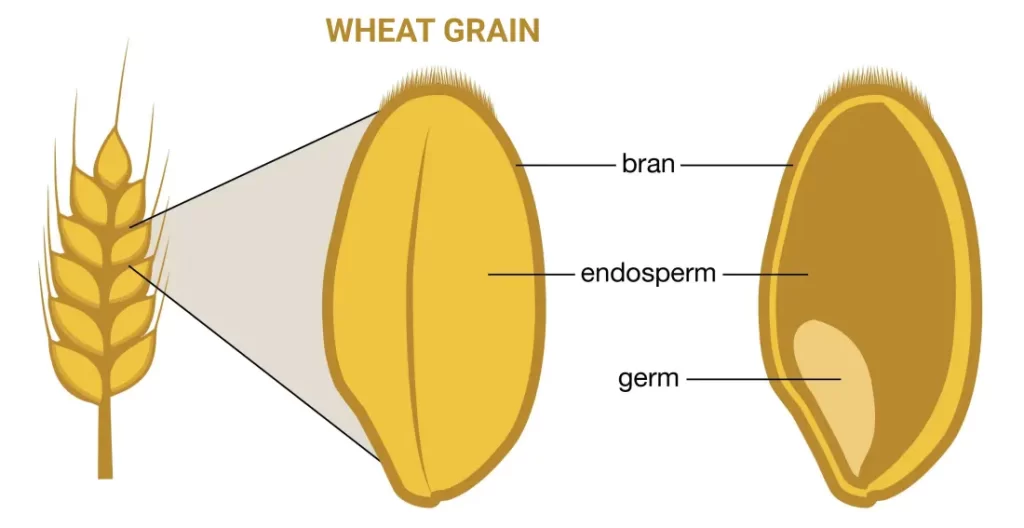The habit of consuming packaged foods, whether in the form of processed meals or convenient snack packs, has become an undeniable aspect of the modern life. Many of us either don’t want to or simply can’t alter this faulty habit. Tempting flavors, easy accessibility, affordability, and targeted marketing all play significant roles in influencing our food preferences.
After a study, we narrowed down the four primary ingredients of our daily diet and aimed to explain their health effects. Our sole intention is to empower you with the knowledge about your food choices.
Table of Contents
Refined Wheat Flour / All-Purpose Flour (Maida):
We frequently encounter the notion that refined wheat flour can be detrimental to our digestive health, while whole wheat flour poses no such concerns. This prompts us to inquire about the difference between these two variants, considering they both originate from the same ingredient, Wheat.
Well, the fundamental difference lies in their processing methods and nutritional composition.
Whole-wheat flour is made by grinding the entire wheat kernel, including its bran, germ, and endosperm. Hence, it contains all the essential parts and naturally occurring nutrients of the wheat grain. It is high in fiber that helps in improved digestion and overall health.

Refined wheat flour, on the other hand, is made by milling wheat to remove the bran and germ, leaving only the starchy endosperm. This refining process removes fiber, vitamins, and minerals present in the bran and germ. It is basically a source of carbohydrates without the additional nutritional benefits otherwise found in whole-wheat flour. Refined flour has finer texture and milder flavor compared to whole-wheat flour.
Edible Oils / Fats:
The snacking industry utilizes various oils for frying and flavor enhancement. These oils possess different properties and used by brands based on their value proposition. Olive oil and Canola oil are some of the good oils that are preferred by the brands that offer healthier snacking options. However, palm oil is by far the most popular choice of processed food industry due to its affordability and desirable frying properties. Understanding the implications of consuming palm oil and other trans fats on our health is crucial.
Palm oil contains high levels of saturated fats, which can elevate LDL (bad cholesterol) in the bloodstream. Palm oil, which is 50% saturated, is still a better option compared to palm kernel oil and coconut oil, which are more than 85% saturated. Regular consumption of saturated fats, particularly in fried snacks, increases the risk of cardiovascular diseases such as stroke.
Another devil is trans-fat, which is universally acknowledged for its detrimental impact on our health. Most trans fats are artificially created through a process called hydrogenation. Partially hydrogenated oil, extensively used in numerous processed snacks (baked and fried foods), serves as a significant source of trans fat. Despite their adverse effects, trans fats remain popular among companies due to their convenience, low production costs, and prolonged shelf life. Recognizing its hazards on human health, many countries have implemented bans on the utilization of trans fat in food.
It’s essential for consumers to be mindful of the types of oils and fats present in their snacks and opt for healthier options.
Salt / Sodium:
Salt is the primary source of sodium in our diet. It is one of the most common ingredients that adds flavor to our food and acts as a preservative. It is basically a mineral which is made up of about 40% sodium and 60% chloride. It is commonly referred to as the “table salt” in everyday use.
From the health point of view, sodium is important for maintaining fluid balance in our body; however, it should be consumed within the recommended limits.
Excess sodium signals our kidneys to draw more water in our bloodstream. The extra fluid in our blood vessels causes high blood pressure (hypertension) which ultimately leads to the cardiovascular and kidney diseases.
According to an Indian Council of Medical Research (ICMR) survey, an average Indian adult consumes around 8 grams of salt per day, which is way higher than the recommended levels of 5 grams by WHO. The study revealed that people with obesity, tobacco users, and men (in general) tend to consume more salt. Urban man, with the average consumption of 9.2 g/day, is the highest contributor mongst all class.
Such high intake of salt is one of the major reasons why India is facing higher level of Disability Adjusted Life Years (DALYs) or death rates relating to cardiovascular diseases (CVDs).
Below is the recommended levels of daily salt / sodium intake for an adult.
| Organization | Salt (RDA) | Sodium (RDA) |
|---|---|---|
| World Health Organization (WHO) | Less than 5g of Salt | Less than 2.0g of Sodium |
| Food and Drug Administration (FDA): USA | Less than 6g of Salt | Less than 2.3g of Sodium |
| National Health Service (NHS): UK | Less than 6g of Salt | Less than 2.5g of Sodium |
Note: 5g of salt is about 01 teaspoon. A teaspoon is defined as 5 mL and a tablespoon is defined as 15 mL when used as measurement in cooking.
There’s a common misunderstanding that black salt, pink salt, or rock salt are healthier substitutes for standard table salt. Despite being less refined, their health effects are essentially the same. They share similar properties and impacts on our bodies as regular refined salt. While they may have slightly lower sodium content, the health difference is minimal.
There are some companies offering low-sodium salts, which might be a better choice than your regular salt. However, it’s important to seek advice from a medical expert beforehand, especially as these alternatives could contain higher potassium levels.
Sugar / Sweetener:
Sugar is a general term used to refer to a class of molecules called carbohydrates (carbs). Our body turns this simple carbs into glucose (blood sugar) which is the main source of energy for our body’s cells, tissues, and organs.
Sugar can be subdivided into two major categories;
- Natural Sugars: These are the sugars that naturally occur in the food like fruits, vegetables, etc.
- Added Sugars: Added sugars, also known as Free sugars, are the processed sugar which is usually put in food to make them sweeter.
Like salt, sugar is a very common ingredient in our food, mainly serving to enhance taste and act as a preservative. It’s found in a wide range of foods. However, it’s not just the added sugar that affects our health; refined carbs like bread, cake, and other baked goods can also quickly turn into blood sugar, impacting our well-being.
Below is the recommended levels of daily intake of added / free sugars for an adult.
| Organization | Recommended Dietary Allowances | Reference Qty. |
|---|---|---|
| World Health Organization (WHO) | Less than 10% of Daily Energy Intake | 12 Teaspoons / 50g |
| Food and Drug Administration (FDA): USA | Less than 10% of Daily Energy Intake | 12 Teaspoons / 50g |
| National Health Service (NHS): UK | Less than 5% of Daily Energy Intake | 07 Teaspoons / 30g |
As per WHO and FDA guidelines, if an adult consumes 2,000 calories a day, no more than 200 calories (i.e. 10%) should come from added sugars. 1 gram of sugar contains 4 calories (1 tsp = 1 cube = 4g sugar). Hence, one should not consume more than 50 grams (12 teaspoons / cubes) of added sugars in a day to stay within the recommended guidelines.
The health authority of the UK, NHS, recommends the daily intake of free sugars should not exceed 30 grams (7 teaspoons / cubes) for an adult.
It’s important to note that these recommendations are for added sugars only and not for the naturally occurring sugars that are commonly found in fruits, vegetables, and dairy products. Additionally, individual dietary needs may vary based on factors such as age, sex, activity level, and overall health status.
It is important to keep in mind that Sugar has addictive qualities. When we consume sugary foods or drinks, they activate our sweet-taste receptors on the tongue. These receptors send signals to our brain, triggering the release of dopamine in our reward system. This dopamine release creates a pleasurable sensation, leading us to crave more sugary foods as they give our brain a ‘happy’ feeling. Excessive sugar consumption disturbs the normal functioning of our brain, increases cravings, and raises our sugar tolerance.
The food industry often uses sugar to make products more cost-effective. They do this by substituting a certain amount of expensive ingredients with sugar, making the food tastier. Many processed food items contain high levels of sugar; cleverly disguised under various names and surreptitiously slipped into our everyday food without us knowing it.
One of the most common terms used by the industry to describe added sugars on a product’s ingredient list is “sweeteners”. This is confusing for many customers, as “sugar” is commonly perceived to be the “table sugar”.
The Harvard School of Public Health enlists some alternative names for added sugar to be aware of:
| Agave Nectar | Brown Sugar | Cane Crystals | Cane Sugar |
| Coconut Sugar | Corn Sweetener | Corn Syrup | Crystalline Fructose |
| Dextrose | Evaporated Cane Juice | Fructose | Fruit Juice Concentrates |
| Glucose | High-Fructose Corn Syrup | Honey | Invert Sugar |
| Malt Sugar | Malt Syrup | Maltose | Maple Syrup |
| Molasses | Raw Sugar | Sucrose | Refined Sugar |
Conclusion
One essential practice to adopt is to read labels of our food products. They reveal crucial information about our food that may otherwise go unnoticed. By being mindful of both the ingredients and portion sizes, positive changes in your health are bound to follow soon.




